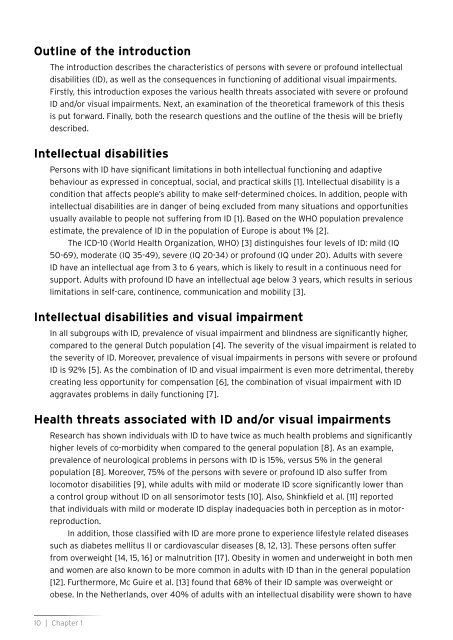Measuring physical fitness in Persons with Severe/Profound ...
Measuring physical fitness in Persons with Severe/Profound ...
Measuring physical fitness in Persons with Severe/Profound ...
- No tags were found...
You also want an ePaper? Increase the reach of your titles
YUMPU automatically turns print PDFs into web optimized ePapers that Google loves.
Outl<strong>in</strong>e of the <strong>in</strong>troductionThe <strong>in</strong>troduction describes the characteristics of persons <strong>with</strong> severe or profound <strong>in</strong>tellectualdisabilities (ID), as well as the consequences <strong>in</strong> function<strong>in</strong>g of additional visual impairments.Firstly, this <strong>in</strong>troduction exposes the various health threats associated <strong>with</strong> severe or profoundID and/or visual impairments. Next, an exam<strong>in</strong>ation of the theoretical framework of this thesisis put forward. F<strong>in</strong>ally, both the research questions and the outl<strong>in</strong>e of the thesis will be brieflydescribed.Intellectual disabilities<strong>Persons</strong> <strong>with</strong> ID have significant limitations <strong>in</strong> both <strong>in</strong>tellectual function<strong>in</strong>g and adaptivebehaviour as expressed <strong>in</strong> conceptual, social, and practical skills [1]. Intellectual disability is acondition that affects people’s ability to make self-determ<strong>in</strong>ed choices. In addition, people <strong>with</strong><strong>in</strong>tellectual disabilities are <strong>in</strong> danger of be<strong>in</strong>g excluded from many situations and opportunitiesusually available to people not suffer<strong>in</strong>g from ID [1]. Based on the WHO population prevalenceestimate, the prevalence of ID <strong>in</strong> the population of Europe is about 1% [2].The ICD-10 (World Health Organization, WHO) [3] dist<strong>in</strong>guishes four levels of ID: mild (IQ50-69), moderate (IQ 35-49), severe (IQ 20-34) or profound (IQ under 20). Adults <strong>with</strong> severeID have an <strong>in</strong>tellectual age from 3 to 6 years, which is likely to result <strong>in</strong> a cont<strong>in</strong>uous need forsupport. Adults <strong>with</strong> profound ID have an <strong>in</strong>tellectual age below 3 years, which results <strong>in</strong> seriouslimitations <strong>in</strong> self-care, cont<strong>in</strong>ence, communication and mobility [3].Intellectual disabilities and visual impairmentIn all subgroups <strong>with</strong> ID, prevalence of visual impairment and bl<strong>in</strong>dness are significantly higher,compared to the general Dutch population [4]. The severity of the visual impairment is related tothe severity of ID. Moreover, prevalence of visual impairments <strong>in</strong> persons <strong>with</strong> severe or profoundID is 92% [5]. As the comb<strong>in</strong>ation of ID and visual impairment is even more detrimental, therebycreat<strong>in</strong>g less opportunity for compensation [6], the comb<strong>in</strong>ation of visual impairment <strong>with</strong> IDaggravates problems <strong>in</strong> daily function<strong>in</strong>g [7].Health threats associated <strong>with</strong> ID and/or visual impairmentsResearch has shown <strong>in</strong>dividuals <strong>with</strong> ID to have twice as much health problems and significantlyhigher levels of co-morbidity when compared to the general population [8]. As an example,prevalence of neurological problems <strong>in</strong> persons <strong>with</strong> ID is 15%, versus 5% <strong>in</strong> the generalpopulation [8]. Moreover, 75% of the persons <strong>with</strong> severe or profound ID also suffer fromlocomotor disabilities [9], while adults <strong>with</strong> mild or moderate ID score significantly lower thana control group <strong>with</strong>out ID on all sensorimotor tests [10]. Also, Sh<strong>in</strong>kfield et al. [11] reportedthat <strong>in</strong>dividuals <strong>with</strong> mild or moderate ID display <strong>in</strong>adequacies both <strong>in</strong> perception as <strong>in</strong> motorreproduction.In addition, those classified <strong>with</strong> ID are more prone to experience lifestyle related diseasessuch as diabetes mellitus II or cardiovascular diseases [8, 12, 13]. These persons often sufferfrom overweight [14, 15, 16] or malnutrition [17]. Obesity <strong>in</strong> women and underweight <strong>in</strong> both menand women are also known to be more common <strong>in</strong> adults <strong>with</strong> ID than <strong>in</strong> the general population[12]. Furthermore, Mc Guire et al. [13] found that 68% of their ID sample was overweight orobese. In the Netherlands, over 40% of adults <strong>with</strong> an <strong>in</strong>tellectual disability were shown to have10 | Chapter 1











